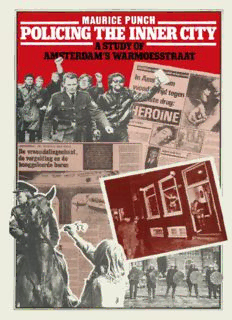
Policing the Inner City: A Study of Amsterdam’s Warmoesstraat PDF
Preview Policing the Inner City: A Study of Amsterdam’s Warmoesstraat
POLICING THE INNER CITY By the same author PROGRESSIVE RETREAT: A SOCIOLOGICAL STUDY OF DARTINGTON HALL SCHOOL AND SOME OF ITS FORMER PUPILS FOUT IS FOUT: GESPREKKEN MET DE POLITIE IN DE BINNENSTAD V AN AMSTERDAM POLICING THE INNER CfI'Y A Study of Amsterdam's Warmoesstraat Maurice Punch Reader in Sociology The Netherlands School of Business Nijenrode © Maurice Punch 1979 Softcover reprint of the hardcover 1s t edition 1979 All rights reserved. No part of this pUblication may be reproduced or transmitted, in any form or by any means, without permission First published 1979 by THE MACMILLAN PRESS LTD London and Basingstoke Associated companies in Delhi Dublin Hong Kong Johannesburg Lagos Melbourne New York Singapore Tokyo Photosetting by Vantage Photosetting Co. Ltd., Southampton and London British Libnuy Cataloguing in Publication Data Punch, Maurice Policing the inner city 1. Police - Netherlands - Warmoesstraat I. Title 363.2'09492'3 HV7759.A/ ISBN 978-1-349-03993-7 ISBN 978-1-349-03991-3 (eBook) DOI 10.007/978-1-349-03991-3 This book is sold subject to the standard conditions of the Net Book Agreement For Corry, Julio and Maria Contents Preface ix Map of the Warmoesstraat Police District xi 1 Observation and the Police: The Research Experience 1 2 Introduction: Crime and the Police in Amsterdam 19 3 The Warmoesstraat: Police Work in the Inner City 55 4 On Becoming a Policeman in the Warmoesstraat 86 5 Street Encounters 117 6 Crime, Drugs and Blacks in the Inner City 149 7 Conclusions: Police and the Inner City 179 Appendix: The Dutch Police 193 Bibliography 197 Index 225 Preface I am indebted to the Amsterdam Police for the excellent co-operation and hospitality which marked the research. In particular, I should like to express my sincere thanks to the Chief Constable of Amsterdam, Mr Th. Sanders, for opening the doors of his force to scrutiny from outside, and also Chief Inspector J. H. Nicaise, Head of the Warmoes straat Police District, who allowed me the freedom of his station and supported the research at every stage. I also received inestimable help within the force, and in some cases comments on drafts of papers and the typescript of this book, from Jella Kuiper, Bob Visser, Henny Elout, Aaldert van de Vlies, Hans van de Horst, Evert Jagerman, Harry van der Woude, Willem van Lieshout, Iebe de Wolf and J aap de Vries. In the Warmoesstraat itself I was identified with one group, who put up with me uncomplainingly, and the research was greatly depen dent upon their co-operation. I am grateful to them all, but especially the 'brigadiers' - Gouke Nijholt, Ernst Wetjens and Helmut Olivier and the 'agenten' - particularly Ruud Valentijn, Hans Achterberg, Willem van Hattum, Tinus Noorlander, John Voorn, Jan van Looijen, Paul Walgering, Joop Meijer, Jan Steiner, Rob van de Kwast, Rob Drenthe, Rob Raat and Gerrit Bouwhuis. Initially I was put on the police trail by my involvement with policemen studying at the Univer sity of Essex and I learnt a great deal from Terry Watson, Geoffrey Markham, Trevor Naylor, Barry Devlin, Robin Blackmore, Ralph Crawshaw, John Watson and John Sutton. A number of people commented on a sprawling manuscript and their criticisms helped me to shape and prune the material into acceptable form; my thanks are due to Wim Broer, Kees Schuyt, Lo Brunt, Frank Bovenkerk, Joep Toebosch, Jim Olila, Simon Holdaway, John Brown, Peter Manning, Mike Chatterton, Garry Brana-Shute, Michael Banton, Bram de Swaan, Ton Peters, and the anonymous reader of the publisher. Dennis Marsden wasted two sunny days of a sabbatical struggling with the meandering script and my guilt is mixed with respect for his shrewd and useful comments. A special mention x Preface must go to Derek Phillips, who not only helped to preserve my sanity during periods of acute culture-conflict by pennitting me to beat him weekly at squash, but who acted as an informal supervisor to the project. He brought my attention to books and articles, helped to develop a theme for the work, and closely read various drafts. His help and encouragement were invaluable. I also appreciate the speed and efficiency of Mevrouw G. de Wit-Smit, Mary Girling, Linda Peachey, Eleanor Hunter, Hanneke Beyer and Nely van Westerop, who worked on the typescript. Henk Jarring kindly helped with the index. I should also perhaps mention here four important pieces of work which I read only after the field-work was completed. I only obtained a copy of Rubinstein's City Police in 1976; was provided with two draft articles by Simon Holdaway this year; was kindly sent a typescript of Police Work by Peter Manning in the early summer (it has since been published); and could only get my hands on Mike Chatterton's excel lent thesis when it was too late to incorporate his material into my book. Finally, virtually moving house five times in five years, for various periods associated with research and study-leave, with two small children and enduring the strains of shift-work placed no small burden on my family. That is why this book is dedicated to the three people who suffered the absences and the restlessness while I was playing at policeman and who survived the gloomy, quasi-masochistic preoccu pation with 'the book' . MAURICE PuNCH Amstelveen, December 1977 SpalrndlmmerbuuTl A. B .tordun C Red hWhI A'eI E WnlirnOock, o Aru Indust"il E C I L O P T AM AA RD TR SE S ET OS M M A R AL WA R E T HN TE F C OG S N EDI I RU AL DC NN OUT, I BC G RI NT WIDIS O H S P A M 1 1
